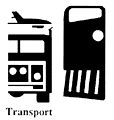|
Transport
 Issues Issues
- Greenhouse and the transport sector.
- Urban air quality.
- Transport efficiency, including vehicle efficiency
and design.
- Urban design and its relationship with transport
- Social equity in the transport sector.
Summary of Final Report
In its considerations of achieving ESD in the sector the
Working Group examined the greenhouse threat, impacts on
urban amenity and interurban transport; the contribution
that vehicle technology and alternative fuels can make to a
more ecologically sustainable transport sector; urban
systems; options for more sustainable interurban transport;
policy and policy instruments.
Key recommendations:
Although a central focus of the Group s work was on the
transport sector's contribution to reductions in greenhouse
gas emissions, recommendations will bring a wider range of
ESD benefits.
The Working Group recommends that:
- comprehensive information, education and consultation
programs to improve community understanding of, and
participation in, the transport related aspects of
ESD;
- all governments to take account of ESD in their
decision making regarding investment in transport
infrastructure;
- studies to be undertaken as to how best incorporate
the full economic, social and environmental cost into
energy prices in Australian transport.
taxes and tradable emissions:
- the merits of a carbon tax and a tradable emissions
scheme in reducing greenhouse gas emissions, including
attention to international competitiveness, and equity
issues, to he examined;
- concessions within the existing fringe benefits tax
(FBT) system that encourage the provision of company cars
be eliminated and the elimination of sales tax exemption
for governments in the purchase of new vehicles.
fleet cars:
- governments to downsize car fleets, improve fleet
management, and encourage the use of public transport as
part of salary packages.
air quality and emissions:
- comprehensive air quality studies be carried out in
all major Australian population centres to provide a
basis for determining the most effective means of
achieving air quality objectives;
- vehicle emission and fuel consumption testing
facilities be maintained, developed or established;
- more comprehensive new and tighter emission limits be
introduced for diesel and petrol engine vehicles;
- development and improvement of programs to detect and
rectify vehicles emitting visihle smoke.
consumption rates:
- all new cars to be labelled to indicate fuel
consumption rates as achieved under a properly audited
test;
- all advertising in relation to the sale of new
vehicles make specific reference to the fuel consumption
figures.
urban densities and urban forms:
- work to increase the level of understanding of urban
planners and managers in the general community of the
ways in which the social, economic, lifestyle and
environmental benefits of higher urban densities and
alternative urban forms in Australian urban communities
can be achieved;
- subsidies on greenfield suburbanisation be phased out
to achieve full cost pricing of urban development;
- inappropriate regulations and processes preventing
re-urbanisation be removed;
- particular attention be paid to redevelopment of land around key
public transport nodes to include dense housing and home commercial
activity so that travel is minimised and public transport facilities
are made more inherently attractive and safe;
- demonstrations of housing systems and urban villages
be provided incorporating affordable and higher density
housing at appropriate locations that can minimise or
reduce travel;
- policies be finalised and implemented immediately to ensure that
affordable housing for all housing groups (in particular for low-income
households and groups in need) is in locations accessible to public
transport, employment, and other essential community facilities, and
that the need for travel is lessened.
bicycles:
- a national cycle strategy which is integrated into
nation transport planning be developed and
implemented.
urban public transport:
- governments and public transport authorities to
identify and implement measures to encourage greater use
of urban public transport services;
- work towards improving the operational efficiency of
urban public transport servlces.
freight transport:
- existing urban transport and land-use planning
arrangements be reviewed to achieve better
integration;
- environmental impact assessment be applied to
transport policies, programs and projects as an essential
part of transport planning and decision making;
- the establishment of a representative consultative
group or process involving government, industry, unions
and other stakeholders to examine the problems faced by
the car industry, the road freight industry, and others
affected by proposed policy changes, to assist in making
the transition necessary to meet ESD goals.
Source: ESD Newsbrief, No 5, December 1991
Back...

|
 Issues
Issues